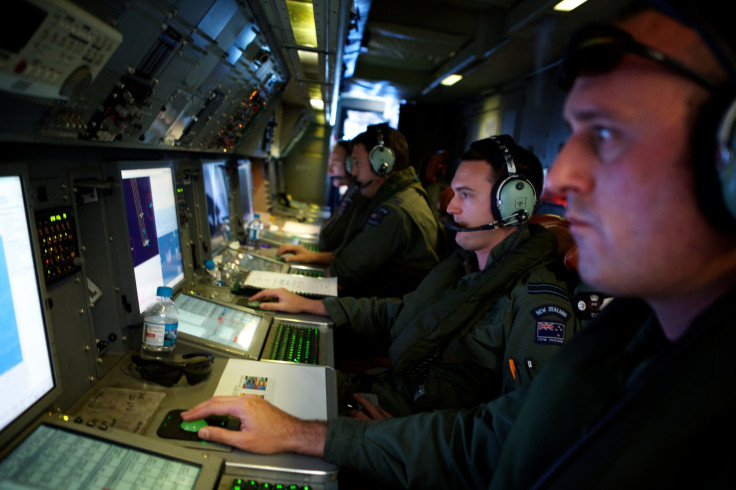MH370 Timeline 2015: When Did Malaysia Airlines Plane Go Missing And What Have Investigators Done Since Then?

A plane wing that washed up Wednesday on Reunion Island, east of Madagascar, was believed to be from a Boeing 777, the same type of aircraft as the long-missing Malaysia Airlines Flight 370. It raised speculation that the plane that has long eluded search parties might soon be discovered nearly a year and a half after it first fell off the radar. What follows is a timeline of events related to Flight 370.
March 8, 2014: Flight 370 takes off from Kuala Lumpur, Malaysia, at 12:41 a.m. local time. The flight is expected to arrive in Beijing at 6:30 a.m. When the flight fails to arrive, a Chinese news agency issues a flash bulletin that contact with the flight has been lost. At 8:11 a.m., the last satellite signal from Flight 370 is detected, although that information would not be known until a week later.
March 9-11, 2014: Search efforts focus on the Gulf of Thailand because the plane was flying over that body of water when contact was initially lost. Speculation is rampant that terrorism might be involved after it is discovered that two passengers on the flight were traveling with stolen passports. Despite that theory, authorities ultimately clear all passengers of any link to terrorism.
March 11-14, 2014: The search for flight concentrates its efforts near Vietnam, the South China Sea and the Gulf of Thailand after aerial photos show suspected crash debris in those areas. After a search in the Andaman Sea turns up empty, evidence begins to mount that the flight had headed west after air-traffic controllers lost radar contact.

March 15, 2014: Satellite transmissions trace the missing aircraft to the Indian Ocean off the coast of Australia. Authorities search the homes of the pilots, Zaharie Ahmad Shah and Fariq Abdul Hamid, and Malaysia's Prime Minister Najib Razak declares that evidence shows the plane was intentionally diverted. Actions taken onboard were deliberate, including the disabling of the plane’s communications systems and the flight’s divergence from its original route, Razak says during a news conference.
March 16-23, 2014: Australia leads the search for the plane in the Indian Ocean after satellite signals show the plane operated for roughly seven hours after its last contact. Personnel from 26 countries take part in the search. New information on March 18 suggests that the change in the flight’s route was programmed into the cockpit computer, raising more speculation about the pilots’ involvement in the disappearance. Investigators try to recover deleted files from a flight simulator discovered at Shah's home earlier in the month, the Associated Press reports March 19. The files had been deleted less than a month before the flight went missing.
March 24, 2014: Razak announces that the flight ended in the Indian Ocean far from any possible landing sites, ruling out any passenger survival. Still, Australia continues to lead the search for the plane.
April 7, 2014: Australia’s Ocean Shield naval vessel detects signals similar to pings, emitting from the missing aircraft’s flight data recorder boxes. But the signals end days later.

April 30, 2014: The aerial search for the plane ends and Australian authorities say they will transition to a more intensified underwater search.
June 10, 2014: Retired Air Chief Marshal Angus Houston, who coordinated the search, says it could take two more years to find the missing plane, but adds that authorities were making progress. He says $60 million has been set aside for the search.
June 20, 2014: New data leads the search team back to waters off Perth, Australia. The data suggest that an area in the Indian Ocean, 1,600 kilometers off the West Australian coast, has the highest probability of being the crash site.
Oct. 8, 2014: The search moves south, and theories about the plane’s fate indicate that it spiraled into the southern Indian Ocean.
Oct. 31, 2014: A Malaysian family sues the country's government, civil aviation authorities, immigration department and air force for negligence regarding the flight's disappearance.

Jan. 29, 2015: Malaysia’s government announces that all passengers and crew on Flight 370 are presumed dead, and that the plane was located on the seafloor of the Indian Ocean.
July 23, 2015: Martin Dolan, chief commissioner of the Australian Transport Safety Bureau, says the missing plane "will be found within the next year." Two vessels continue search operations in the southern Indian Ocean and more than 21,000 of the 46,332 square miles of search area have been covered.
July 29, 2015: A plane wing washes up on the shore of Reunion Island, east of Madagascar. Investigators pursue whether the wing was from the missing Malaysian airplane.
© Copyright IBTimes 2025. All rights reserved.






















